Ford Ranchero
| Ford Ranchero | |
|---|---|
 1967 Ford Fairlane Ranchero | |
| Overview | |
| Manufacturer | Ford |
| Also called |
Ford Falcon Ranchero Ford Fairlane Ranchero |
| Production | 1957–1979 |
| Body and chassis | |
| Class |
Full-sized (1957–1959) Compact (1960–1965) Mid-sized (1966–1979) |
| Body style | 2-door coupe utility |
| Layout | FR layout |
| Related | Fairlane, Falcon, Galaxie, Torino, LTD II, Ford Durango |
The Ford Ranchero is a coupe utility that was produced by Ford between 1957 and 1979. Unlike a pickup truck, the Ranchero was adapted from a two-door station wagon platform that integrated the cab and cargo bed into the body. A total of 508,355 units were produced during the model's production run.[1] It was adapted from full-sized, compact, and intermediate automobiles sold by Ford for the North American market.
During the 1970s, the Ranchero name was used in the South African market on a rebadged Australian Ford Falcon utility. These vehicles were sent to South Africa in complete knock down (CKD) form, and assembled at the Port Elizabeth plant.[2] In Argentina, a utility version of the locally produced Ford Falcon was also called Ranchero.[3]
The Ford Ranchero sold well enough to spawn a competitor from General Motors in 1959, the Chevrolet El Camino.[4]
History
The first Ford Model T and Model A pickup trucks were created from sedans by placing a truck box behind the body of a car truncated behind the driver's seat. In 1934, Ford Australia's designer Lew Bandt modified a coupe with a smoothly integrated loadbed that could be used like a car to drive to church or to deliver pigs to market. This created the coupe utility which remains a popular body style known as the "ute" in Australia.[5] In North America, pickup trucks evolved into a heavier duty form with cabs and beds that were quite distinct from passenger automobiles. The Ranchero was the first postwar American vehicle of its type adapted from a popular sedan from the factory. It combined the sleek looks of a sedan with the utility of a light-duty pickup truck.
First generation (1957–1959)
| First generation | |
|---|---|
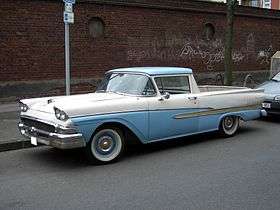 1958 Ford Ranchero | |
| Overview | |
| Also called | Meteor Ranchero (Canada) |
| Production | 1957–1959 |
| Assembly |
Lorain, Ohio, United States Oakville, Ontario, Canada[6] |
| Body and chassis | |
| Related | 1957 Ford |
| Powertrain | |
| Engine |
223 CID (3.7 L) OHV I6 292 CID (4.8 L) Y-block V8 352 CID (5.8 L) FE V8 |
| Dimensions | |
| Wheelbase | 116–118 in (2,946–2,997 mm)[7] |
| Length | 202.0 in (5,131 mm)[8] |
Introduced in December 1956, three months after the traditional September model year start-up, the Ranchero was based on the standard and new-for-1957 full-sized Ford platform, specifically the short-wheelbase Custom sedan, two-door Ranch Wagon station wagon, and utilitarian Courier sedan delivery. Essentially a Courier with an open, reinforced bed, its own unique rear window and integrated cab and cargo box, the Ranchero was initially offered in two trim levels, and throughout the model run, was built on the corresponding automobile assembly line, but sold as a truck through Ford's truck division. An extremely basic standard model was marketed to traditional pickup truck buyers such as farmers, and the Custom picked up most of the options and accessories available on the Fairlane line, including stainless steel bodyside mouldings and two-tone paint. Upscale models were badged both as a Fairlane and Ranchero, with a stylized representation of a Longhorn as the symbol for the model located on the tailgate. Indeed, print advertising of the time played on the theme of the American Southwest that the Spanish model name and Longhorn symbol were meant to evoke, showing artistic representations of the vehicle being used in ranching and outdoor activities, proclaiming it as "More Than A Car! More Than A Truck!" The Ranchero was a hit with both the automotive press and the buying public, filling an untapped market niche for vehicles with the utility of a light pickup and the ease of operation and riding characteristics of a car. In fact, the Ranchero had a marginally higher cargo capacity by about 50 lb (23 kg) than the half-ton F-Series pickup. Both standard and Custom could be ordered with any engine available for Ford cars, all the way up to the 352 cu in (5.8 L) "Thunderbird Special". In Canada, the Ranchero was also available in the Meteor line-up. Seat belts and padded instrument panels were optional.[7]
The 1958 version remained largely unchanged under the skin save for the new front sheet metal (shared by the big '58 Ford and inspired by the Thunderbird)[8] and its new four-headlamp arrangement.
The 1959 model was built with the same 118 in (3,000 mm) wheelbase as all 1959 Fords, giving the Ranchero the advantage over its predecessors of a new, longer 7 ft (210 cm) bed.[9] However, this would be the last time the vehicle would grow either in size or trim for several years to come. The windshield was also 25% larger.[9] Seatcovers were vinyl or "woven plastic",[9] while the spare tire was located behind the passenger seat.[9] The Custom Ranchero was the only model marketed in 1959,[8][10] and was offered in 26 colors (11 solid shades, 11 two-tone combinations with white on top, and four other two-tone choices).[9]
 1957 Ford Custom Ranchero
1957 Ford Custom Ranchero 1958 Ford Ranchero
1958 Ford Ranchero 1958 Ford Ranchero (rear)
1958 Ford Ranchero (rear) 1959 Ford Ranchero
1959 Ford Ranchero
Second generation (1960–1965) Falcon Ranchero
| Second generation | |
|---|---|
 1964 Ford Falcon Ranchero | |
| Overview | |
| Production | 1960–1966 |
| Assembly |
Lorain, Ohio, United States Buenos Aires, Argentina |
| Body and chassis | |
| Related |
Ford Falcon Ford Fairlane |
| Powertrain | |
| Engine |
144 cu in (2.4 L) 90 hp Thriftpower[8] I6 170 cu in (2.8 L) Thriftpower I6 200 cu in (3.3 L) Thriftpower I6 260 cu in (4.3 L) Windsor V8 289 cu in (4.7 L) Windsor V8 |
| Transmission |
3-speed manual 4-speed manual 3-speed Cruise-O-Matic automatic 3-speed C4 automatic |
| Dimensions | |
| Wheelbase | 109.9 in (2,791 mm)[8][11] |
| Length | 189.0 in (4,801 mm) |
| Width | 70.0 in (1,778 mm) |
| Curb weight | 2,475 lb (1,123 kg) |
In 1960, the Ranchero became much smaller, based on Ford's compact Falcon, specifically the two-door sedan delivery variant. The popularity of small, economical cars like the Volkswagen Beetle perpetuated a shift in thinking among the three largest American manufacturers; 1959 had the introduction of the 1960 Falcon along with the 1960 Chevrolet Corvair and Plymouth Valiant. A pickup version of the Volkswagen Bus and a van based on the Chevrolet Corvair were offered, as well. The economic recession of the late 1950s also certainly played a role. Ford believed the market wanted a more practical vehicle, one much smaller, lighter, and cheaper than a full-sized pickup truck, and indeed the Ranchero sold well in this incarnation. Now marketed in print as the "Falcon Ranchero", the new vehicle's standard powerplant was an economical 144 cu in (2.4 L) straight-6. In 1961, the 170 cu in (2.8 L) straight-6 was offered, and in 1963, the optional 260 cu in (4.3 L) V8 was offered in addition to the 144 and 170. The two-speed Ford-O-Matic automatic transmission (offered between 1960 and 1963) or three-speed C4 Cruise-O-Matic could be ordered as could a three-speed manual transmission. The Ranchero had an 800-lb load capacity.[12]
Three almost entirely different coupé utility bodies were available for this generation of Falcon: the Australian Falcon Ute differed in having a shorter rear overhang than North American models, a cargo box that extended farther forward than the rear window, and shorter doors, while the Argentinian version also shared the sedan's overall length and short "four-door" doors, adding higher and more squared-off cargo box sides.
The Ranchero evolved along with the Falcon in 1964, becoming just a little larger along with its parent and using the same basic body style for 1964 and 1965. In 1965, the 289 cu in (4.7 L) V8 replaced the discontinued 260 and an alternator replaced the generator in all Ford cars.
 1962 Ford Falcon Ranchero
1962 Ford Falcon Ranchero 1963 Ford Falcon Ranchero
1963 Ford Falcon Ranchero 1964 Ford Falcon Ranchero
1964 Ford Falcon Ranchero- 1965 Ford Falcon Ranchero
Third generation (1966–1967)
| Third generation | |
|---|---|
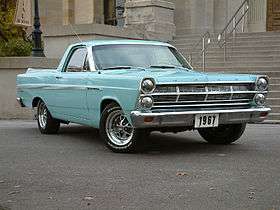 1967 Ford Fairlane Ranchero | |
| Overview | |
| Production | 1967 |
| Assembly | Lorain, Ohio, United States |
| Body and chassis | |
| Related |
Ford Falcon Ford Fairlane |
| Powertrain | |
| Engine |
170 cu in (2.8 L) I6 200 cu in (3.3 L) I6 289 cu in (4.7 L) V8 390 cu in (6.4 L) V8 |
| Transmission |
3-speed automatic 3-speed manual |
| Dimensions | |
| Wheelbase | 113.0 in (2,870 mm)[8] |
The 1966 version was a one-year model, when Falcon and Fairlane were redeveloped on the same basic platform, one which did not include the sedan delivery, as 1965 marked the final year of sedan delivery production. Instead, the 1966 Ranchero used Falcon front sheet metal, trim, and interior accents on a modified station wagon platform although Rancheros made late in the '66 model year had the same front clip as the Fairlane.[13]. Engines available were the 170 cu in (2.8 L) I6, 200 cu in (3.3 L) I6, and two- and four-barrel versions of the 289 cu in (4.7 L) V8. Transmissions choices ranged from the C4 three-speed automatic to the three-speed column-shifted manual. The 1966 model was marketed simply as the Ford Ranchero,[14] and did not carry Falcon badges.[15] Seat belts were standard.[8]
The 1967 Ranchero, based on the post-'66 Falcon/Fairlane chassis, used the basic 1966 Ranchero body with Fairlane trim, front sheet metal, and interior treatments instead of Falcon. It was marketed as the Fairlane Ranchero.[16]
This was a well-received and unique one-year vehicle, with clean, straight lines, dual stacked headlamps, and plenty of power; the Ranchero had entered the muscle car arena in 1967. Engine options started with a 200 cu in (3.3 L) straight-6 and went up to a 390 cu in (6.4 L) FE-series big-block V8 giving 315 bhp (234.9 kW) and backed by an optional C6 automatic, the new-for-1966 heavy duty variant of the C4. The '67 also had the largest expansion of trim levels since the vehicle's introduction 10 years prior. Supplementing the base model were the new Ranchero 500, 500/XL, and GT. The GT-A, Ford's label for '66 and '67 automatic transmission-equipped GTs given to both the Fairlane and Mustang, did not apply to the Ranchero.
What did apply to all American cars in 1967 was the use of a dual-circuit braking system with a dual-chambered master cylinder. Increased awareness of passenger safety resulted in such innovations as safety-padded windshield pillars and an unusual 1967-only safety pad which protruded from the center of the three-spoked steering wheel to a point just beyond the rim of the steering wheel. It was designed to minimize abdominal injuries in the event of a collision.
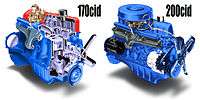 Schematic of Ford's 170 and 200 cid engines used in their automobiles from the early 1960s to 1980s
Schematic of Ford's 170 and 200 cid engines used in their automobiles from the early 1960s to 1980s.jpg) 1966 Ford Ranchero
1966 Ford Ranchero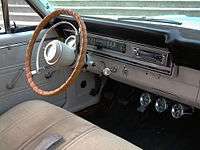 Interior image of a 1967 Ford Ranchero with bench seat and three-speed shifter on the steering column
Interior image of a 1967 Ford Ranchero with bench seat and three-speed shifter on the steering column
Fourth generation (1968–1969)
| Fourth generation | |
|---|---|
 | |
| Overview | |
| Production | 1968–1969 |
| Assembly |
Lorain, Ohio, United States Atlanta, Georgia, United States |
| Body and chassis | |
| Related |
Ford Fairlane Ford Torino Mercury Montego |
| Powertrain | |
| Engine |
250 cu in (4.1 L) I6 289 cu in (4.7 L) V8 390 cu in (6.4 L) V8 428 cu in (7.0 L) V8 302 cu in (4.9 L) V8 351 cu in (5.8 L) V8 |
| Transmission |
3-speed manual 4-speed manual 3 and 4-speed automatic |
| Dimensions | |
| Wheelbase | 113.0 in (2,870 mm) |
In 1968, the Fairlane line was supplemented by the new Torino, and the Ranchero followed suit, becoming the largest model since the full-sized 1959. Overall, the new Ranchero was not only bigger, but also more angular than before with its more horizontal grille and horizontal headlamps; Ford and other automakers were making a switch back to horizontal quad headlamps. The interior was all new, as well, sharing the Torino/Fairlane's distinctive four-pod instrument cluster. Though the four round pods gave the illusion of an engine-turned dash, viewed from left to right, they instead featured warning lights for coolant temperature (both cold and hot) and the left turn signal indicator in the left pod with the speedometer in the second pod directly in front of the driver. Warning lights for the charging system and oil pressure, as well as the right turn signal indicator, were located third from the left. In upscale models, this pod was supplanted by a tachometer. An optional clock filled the fourth pod; a decorative "clock delete" panel otherwise filled the space. A seat belt warning light was a new feature, too, lighting briefly in the far left pod whenever the engine was started. The model line also featured wraparound front side marker lamps which doubled as parking lights and rear side reflectors, newly mandated by US law for the 1968 model year.
_1969.jpg)
Three trim levels were offered, beginning with the sparsely trimmed base Ranchero, the Ranchero 500 trimmed like the corresponding Fairlane 500, and the top-of-the line Ranchero GT with its Torino GT trim. Engine choices began with the 250 cubic inch I6 and ran to several V8 choices, including the standard 289 with two-barrel carburetor, and the FE-based 390. The powerful 428 cu in (7.0 L) Cobra Jet, another FE derivative and the largest engine offered in the Ranchero to date, was a mid-1968 option. The 1968 model marked the final year of production of the 289; a 302 cu in (4.9 L) V8 with two-barrel carburetor became the standard V8 in 1969. Two new upmarket engine choices were available, the 351 Windsor with two- and four-barrel carburetion. The FMX automatic was available with both, which was a variant of the old Cruise-o-Matic and was offered exclusively with either 351.
Like the Torino/Fairlane, the Ranchero could be had with virtually all of the same options as its cousins, including air conditioning, bucket seats, center console, AM/FM radio, optional wheels, front power disc brakes, hood scoop (standard on GT), and even a vinyl top. Changes across the 1969 model line were slight and included a flatter three-piece grille less the horizontal crossbar and Ford crest, relocation of GT grille badging from the crest to the lower right corner of the grille as viewed from the front, a change from black-faced instruments with white numerals to brushed aluminum with black numerals and a slimmer, two-spoke steering wheel pad similar to those across the Ford product line, unlike the wheel with its broader "safety pad" and separate horn ring used in the 1968 intermediates and compacts. While the pad may have changed, the horn ring did not. The only change unique to the Ranchero was the relocation of the "Ranchero" script from the rear quarter panels to the front fenders.
A little-known and extremely rare offering in 1969 was the Rio Grande. Available on special order, this was essentially a GT in the so-called "Grabber" colors of "Wimbledon White", "Poppy Red" or "Calypso Coral", partially blacked-out hood with scoop, side stripes, bed rails, vinyl top, and unique "Ford Ranchero Rio Grande" wheel centers. As a result, Rancheros so equipped received Ford's "Special Performance Vehicle" identification on the data plate regardless of engine choice. These vehicles may be identified by the aforementioned designation, as well as a blank space where the trim code would normally be found. Production figures are unclear, but may have been around 900 total units.
At the Detroit motor show in 1969 was shown a concept car Ford Scrambler, some elements of which were used in the next models of Ford Ranchero.
Fifth generation (1970–1971)
| Fifth generation | |
|---|---|
 | |
| Overview | |
| Production | 1970–1971 |
| Assembly | Lorain, Ohio, United States |
| Body and chassis | |
| Related |
Ford Torino Mercury Montego |
| Powertrain | |
| Engine | 429 cu in (7.0 L) V8 |
| Dimensions | |
| Wheelbase | 114.0 in (2,896 mm) |
While Chevrolet's El Camino used the same body from 1968 to 1972, 1970 had a complete restyle for the Ranchero, which had started with a boxy body style. Both the Torino and Ranchero featured a shallow-pointed grille and front end with smooth, somewhat more curvaceous lines influenced by coke bottle styling. A fourth trim option was made available in 1970. The Ranchero Squire was an upmarket trim package which featured a woodgrain applique similar to that found on the Country Squire station wagon. Like in previous years, all Torino trim and engine options could be ordered, including all-new Ram-Air 429 Cobra Jet or Super Cobra Jet engines (7 L) with the new "shaker" hood scoop, so named because it was directly mounted to the carburetor and shook with the engine at idle. Also available was a stylish grille that featured hide-away headlamps, as well as an optional hood with an oversized scoop which was standard on Torino GTs. The 1971 is distinguished by a grilled divided by a center section.
A minor but nevertheless important variation debuted with the 1970 model. Prior to 1970, no Ranchero had any interior badging identifying it as such. With the 1970 model came a "Ranchero" or "Ranchero GT" badge on the glove compartment rather than Fairlane or Torino badging.
Sixth generation (1972–1976)
| Sixth generation | |
|---|---|
.jpg) 1972 Ford Ranchero GT | |
| Overview | |
| Production | 1972–1976 |
| Assembly | Lorain, Ohio, United States |
| Body and chassis | |
| Related |
Ford Elite Ford Torino Mercury Montego Mercury Cougar |
| Powertrain | |
| Engine |
250 cu in (4.1 L) I6 302 cu in (4.9 L) V8 351 cu in (5.8 L) V8 400 cu in (6.6 L) V8 429 cu in (7.0 L) V8 460 cu in (7.5 L) V8 |
| Transmission |
4-speed manual 3-speed automatic |
| Dimensions | |
| Wheelbase | 118.0 in (2,997 mm)[17] |
In 1972, a radical change occurred in the Torino and Ranchero lines. The sleek, pointy look of the previous year's model was replaced with a larger, heavier design. Most prominent was a wide semioval grille reminiscent of a jet intake and a new body-on-frame design. Three models were still available; the now-standard 500, the new Squire with simulated woodgrain "paneling" along the flanks, and the sporty GT. Engine choices remained basically the same beginning with the 250 cubic-inch six-cylinder and a selection of V8s that ranged from the standard 302 to Cleveland and Windsor series 351s, plus the new-for-1972 400. The 385-series V8 (the 429 for 1972-73; the 460 for 1974-76) was still available. However, all suffered from lower compression ratios to better meet new emissions standards. The 351 cu in (5.8 L) Cleveland could still be obtained in tuned 4-V Cobra Jet form through 1974. A four-speed manual transmission was available on Cobra Jet-powered GT models.
The 1973 Ranchero had a redesigned front end to meet new federal standards for front impact protection. Aside from slight cosmetic differences, the Ranchero remained basically the same until the Torino's final year, 1976.
.jpg) 1972 Ford Ranchero GT
1972 Ford Ranchero GT 1973 Ford Ranchero 500
1973 Ford Ranchero 500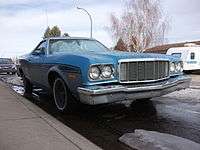 1974–1976 Ford Ranchero
1974–1976 Ford Ranchero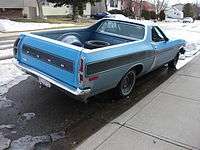 1974–1976 Ford Ranchero
1974–1976 Ford Ranchero
Seventh generation (1977–1979)
| Seventh generation | |
|---|---|
 | |
| Overview | |
| Production | 1977–1979 |
| Assembly | Lorain, Ohio, United States |
| Body and chassis | |
| Related |
Ford LTD II Mercury Cougar |
| Powertrain | |
| Engine |
302 cu in (4.9 L) V8 |
| Dimensions | |
| Length | 220.1 in (5,591 mm)[8] |
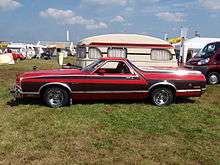
With the Torino ending production after 1976, the 1977 Ranchero was restyled in line with the Ford LTD II mid-sized car line which replaced the Torino using the same platform. The same three models available since 1968 were still offered and the Ranchero could be ordered in quite luxurious form. Engines fitted went up to the 400 cu in (6.6 L). Production ceased in 1979 with, among the traditional choices, a commemorative "1979½" model. Although the LTD II was not produced for many model years, this body style with stacked rectangular headlamps is among the most popular among collectors.
Cars were getting smaller and increasing government restrictions, and requirements on a car-based pickup truck made such a vehicle less and less attractive from a manufacturing standpoint. Meanwhile, purpose-designed light trucks had to meet much less stringent requirements for emissions and fuel economy. Ford saw the way the market was going and decided small light trucks were the wave of the future, beginning with the Mazda-built Courier pickup. This vehicle would be a "stepping stone" during which time Ford would develop their homegrown replacement, the Ranger.
Argentine Ranchero
From 1973 to 1991, Ford Motor Argentina developed and sold a utility version of its own Ford Falcon called the Ford Ranchero. The first generation sold very well, and in 1974, exports began to Cuba. Later that year, it became the best-selling car in Argentina, with a total of 110,382 sold between 1973 and 1978.[3] Production of the second-generation model lasted from 1978 to 1982, and production of the third generation lasted from 1982 to 1987. In 1987, the fourth and final generation was released and in 1988 a diesel model was added to the lineup for the first time, but it was discontinued as of 1989. Production of the fourth-generation Argentine Ranchero ended in 1991.[18]
Today
Rancheros are reasonably collectible, though they are nowadays often overlooked in favor of the later-arriving Chevrolet El Camino, which stayed in production eight more years. Miniatures, apart from hand-cast resin kits from cottage-industry makers,[19] are rare. Several Revell offerings of the 1957 model in both 1/32 and 1/25 scale have been offered over the years, as has a kit of the 1961 Ranchero by AMT/Ertl. A well-detailed promotional model of the 1959 intended for distribution by dealers was offered both with and without interior trim, windows, and friction drive by AMT/Ertl's predecessor, SMP; resin castings of this model's body are offered by the aforementioned cottage industries, as well. No Matchbox versions were made, but Johnny Lightning makes a 1964 model, Hot Wheels an adult collectible '57, and 2011 HW Premiere 65 Ford Ranchero Racing Champions made a 1/64 scale 1957 Ranchero and AMT/Ertl currently produces a diecast '57 which doubles as a bank. AMT was responsible for other early dealer promotional models, too, including those of the aforementioned El Camino. Tonka produced a resin toy version of the 1968-69 model in roughly 1/24 scale as part of an auto transporter set; the front end of that toy arguably resembles the 1969 model more closely.
The idea of a car-based pickup remains an attractive one, and is an illustration of how favorable treatment for light trucks over cars by United States regulations skews the marketplace. Many Ranchero and El Camino owners, indeed, stopped buying new vehicles when those models were discontinued. Aftermarket conversions of the Fairmont Futura and Mercury Zephyr Z7 sport coupes to a Ranchero-like "Durango" pickup were sold in select Ford dealers in the early- to mid-1980s. Recently, interest in producing such vehicles again has grown, including those like the Subaru Baja, essentially an Outback station wagon with a stubby pickup bed instead of an enclosed cargo area. The Baja, like the Ranchero, is titled in most American states and Canadian provinces as a commercial vehicle. Until the late-2000s, the North American market tended to lean towards compact and midsized crew-cab four-door pickups such as the Ford Explorer Sport Trac and Chevrolet Colorado. However, with the compact pickups having grown towards midsized and encroaching on base models of more profitable full-sized pickups, some manufacturers such as Ford and Ram Trucks have discontinued even their compact and midsized offerings; Ford discontinued the North American Ranger in 2012 and opted not to sell its global replacement in North America due to being too close in size and price to the base model Ford F-150.[20]
In Australia, Ford produced a right-hand drive car based "pickup", with the FG X Falcon Ute available in style-side or tray-back form. Production of Falcon sedans and utilities ceased in Australia in 2016.
References
- ↑ "Ford Ranchero History and Production Figures". Dearborn Classics. Retrieved 2009-10-30.
- ↑ 1972 Ranchero Bakkie - Australian XA Falcon Ute Retrieved on 8 May 2010
- 1 2 "FORD FALCON 1973" (in Spanish). Todo Falcon. Retrieved 16 October 2011.
- ↑ "Chevrolet El Camino". OldRide.com. Retrieved 16 October 2011.
- ↑ "The First Ute Broadcast 06/02/2003". Abc.net.au. Retrieved 2011-11-20.
- ↑ oldcarsweekly.com
- 1 2 "Directory Index: Ford_Ranchero/1957_Ford_Ranchero_Foldout". Oldcarbrochures.com. Retrieved 2011-11-20.
- 1 2 3 4 5 6 7 8 Gunnell, John A. (1993). Standard Catalog of American Light-Duty Trucks. krause Publications. ISBN 0-87341-238-9.
- 1 2 3 4 5 Old Car Brochures Retrieved 5 October 2013.
- ↑ Mike Mueller, Pickup Trucks, 1999, p.127 As retrieved from books.google.com.au on 19 February 2011
- ↑ "Directory Index: Ford_Ranchero/1965_Ford_Ranchero_Foldout". Oldcarbrochures.com. Retrieved 2011-11-20.
- ↑ "Directory Index: Ford_Ranchero/1961_Ford_Ranchero_Foldout". Oldcarbrochures.com. Retrieved 2011-11-20.
- ↑ 1966 Ford Ranchero with Fairlane front clip Retrieved from momentcar.com 7/23/2017
- ↑ 1966 Ford Ranchero brochure Retrieved from www.webcitation.org on 19 February 2011
- ↑ 1966 FORD FALCON PRODUCTION FIGURES Retrieved from www.westcoastfalcons.com on 19 February 2011
- ↑ 1967 Ford Fairlane Ranchero advertisement Retrieved from www.flickr.com on 19 February 2011
- ↑ "Directory Index: Ford_Ranchero/1975_Ford_Ranchero_Brochure". Oldcarbrochures.com. Retrieved 2011-11-20.
- ↑ "FORD MOTOR ARGENTINA S.A." (in Spanish). Coche Argentino. Retrieved 16 October 2011.
- ↑ Motor City Resin Casters. "72' Ranchero Trans-Kit".
- ↑ MotorTrend.com First Look: 2012 Ford Ranger - 90 Percent of an F-150, 100 Percent Not Coming Here - Benson Kong, 15 October 2010
External links
| Wikimedia Commons has media related to Ford Ranchero. |
- Ranchero in the Netherlands/Europe
- Dearborn Classics' Ranchero history page with photos
- Ranchero and coupe utilities in Sweden
- Bill's Classic Cars - 1967 Ranchero
- 63 V8 4-Speed Ranchero Registry
- Naming the Unnamed Pontiac Sport Truck
- The Ranchero Fan Club
- Falconparts.com
- Official website of the Ford Discovery Centre of Australia
- 1963 Ford Ranchero
| « previous — Ford Motor Company light truck timeline, North American market, 1946–1979 — next » | ||||||||||||||||||||||||||||||||||
|---|---|---|---|---|---|---|---|---|---|---|---|---|---|---|---|---|---|---|---|---|---|---|---|---|---|---|---|---|---|---|---|---|---|---|
| Type | 1940s | 1950s | 1960s | 1970s | ||||||||||||||||||||||||||||||
| 6 | 7 | 8 | 9 | 0 | 1 | 2 | 3 | 4 | 5 | 6 | 7 | 8 | 9 | 0 | 1 | 2 | 3 | 4 | 5 | 6 | 7 | 8 | 9 | 0 | 1 | 2 | 3 | 4 | 5 | 6 | 7 | 8 | 9 | |
| SUV | Bronco | Bronco | ||||||||||||||||||||||||||||||||
| Coupé utility | Ranchero | Ranchero | Ranchero | Ranchero | Ranchero | Ranchero | Ranchero | |||||||||||||||||||||||||||
| Compact pickup | Courier | Courier | ||||||||||||||||||||||||||||||||
| Full-size pickup | Standard/ Deluxe |
F-Series | F-Series | F-Series | F-Series | F-Series | F-Series | |||||||||||||||||||||||||||
| Van | Econoline | Econoline | Econoline / Club Wagon | |||||||||||||||||||||||||||||||